A) inelastic.
B) elastic.
C) robust.
D) inverse.
Correct Answer

verified
Correct Answer
verified
Multiple Choice
If Susan receives $3,000 of value from a computer that she was able to purchase from Joe's Computer Shop for $1,800, this indicates that
A) Susan's opportunity cost of purchasing the computer was $3,000.
B) Joe earned a $1,200 profit on the sale of the computer.
C) Susan reaped a consumer surplus of $1,200 from the purchase of the computer.
D) Joe incurred a loss a $1,200 on the sale of the computer.
Correct Answer

verified
Correct Answer
verified
Multiple Choice
In his book The Wealth of Nations , this famous economist argued that economic activity was directed by an "invisible hand."
A) Alfred Marshall
B) Milton Friedman
C) Adam Smith
D) David Ricardo
Correct Answer

verified
Correct Answer
verified
Multiple Choice
At a price of $5, Sam buys 10 units of a product; when the price increases to $6, Sam buys 8 units. Which of the following is correct about Sam's behavior?
A) Sam's demand has decreased.
B) Sam's demand has increased.
C) Sam's quantity demanded has decreased, and his demand has not changed.
D) Sam's quantity demanded has increased, and his demand has increased.
E) Sam's demand has increased, and his quantity demanded has decreased.
Correct Answer

verified
Correct Answer
verified
Multiple Choice
Economic efficiency requires that
A) individuals take all actions within their power.
B) only long-lasting, high-quality products be produced.
C) income be distributed equally among individuals.
D) all economic activity generating more benefits than costs to individuals in the economy be undertaken.
Correct Answer

verified
Correct Answer
verified
Multiple Choice
Which of the following factors would cause the demand curve for a good to increase (shift to the right) ?
A) a decrease in the price of the good
B) an increase in the price of the good
C) an increase in the price of a substitute good
D) an increase in the price of a complementary good
Correct Answer

verified
Correct Answer
verified
Multiple Choice
If salsa and nacho chips are complements, an increase in the price of nacho chips would
A) increase the price of salsa.
B) decrease the demand for salsa.
C) increase the demand for salsa.
D) have no effect on the demand for salsa.
Correct Answer

verified
Correct Answer
verified
Multiple Choice
Which of the following would most likely decrease the current demand for DVD players?
A) an increase in consumer income
B) an increase in the prices of television sets, a complement for DVD players
C) an expectation that the price of DVD players would rise sharply in the near future
D) an increase in the price of VCRs, a substitute for DVD players
Correct Answer

verified
Correct Answer
verified
Multiple Choice
Suppose the prices of petroleum products, including gasoline and fuel oil, fell sharply. Which of the following would most likely occur as the result of the lower prices of petroleum products?
A) a reduction in the consumption of gasoline
B) an increase in demand for solar heating systems
C) an increase in demand for smaller, more efficient automobiles
D) a reduction in the demand for home insulation products
Correct Answer

verified
Correct Answer
verified
Multiple Choice
When the "invisible hand" guides economic activity, prices of products reflect
A) only the values that society places on those products.
B) only the costs to society of producing those products.
C) both the values that society places on those products and the costs to society of producing those products.
D) none of the above; when the "invisible hand" guides economic activity, prices of products are set by the government in a manner that is thought to be "fair."
Correct Answer

verified
Correct Answer
verified
Multiple Choice
If a small percentage increase in the price of a good results in a rather large percentage increase in the quantity supplied of the good, supply is said to be
A) vertical.
B) relatively inelastic.
C) relatively elastic.
D) robust.
Correct Answer

verified
Correct Answer
verified
Multiple Choice
Figure 3-20 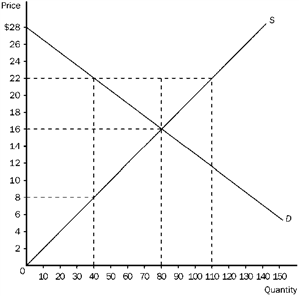 Refer to Figure 3-20. At the equilibrium price, producer surplus is
Refer to Figure 3-20. At the equilibrium price, producer surplus is
A) $480.
B) $640.
C) $1,120.
D) $1,280.
Correct Answer

verified
Correct Answer
verified
Multiple Choice
Figure 3-16 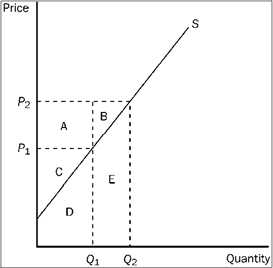 Refer to Figure 3-16. When the price falls from P 2 to P 1, producer surplus
Refer to Figure 3-16. When the price falls from P 2 to P 1, producer surplus
A) decreases by an amount equal to C.
B) decreases by an amount equal to A + B.
C) decreases by an amount equal to A + C.
D) increases by an amount equal to A + B.
Correct Answer

verified
Correct Answer
verified
Multiple Choice
Figure 3-19 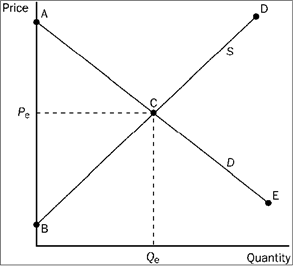 Refer to Figure 3-19. Sellers whose costs are greater than price are represented by segment
Refer to Figure 3-19. Sellers whose costs are greater than price are represented by segment
A) AC
B) CE
C) BC
D) CD
Correct Answer

verified
Correct Answer
verified
Multiple Choice
Which of the following events would increase producer surplus?
A) Sellers' costs stay the same and the price of the good increases.
B) Sellers' costs increase and the price of the good stays the same.
C) Sellers' costs increase and the price of the good decreases.
D) All of the above are correct.
Correct Answer

verified
Correct Answer
verified
Multiple Choice
Consumers buy less of a good as its price increases because
A) production costs have risen.
B) substitute goods are now relatively cheaper.
C) the income of consumers has effectively risen.
D) the higher price will make the good more valuable to each consumer.
Correct Answer

verified
Correct Answer
verified
Multiple Choice
Figure 3-23 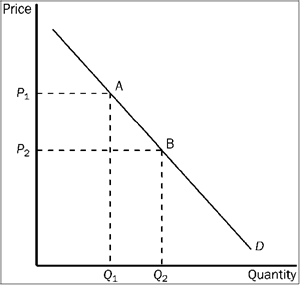 Refer to Figure 3-23. It is apparent from the figure that
Refer to Figure 3-23. It is apparent from the figure that
A) the good is inferior.
B) the demand for the good decreases as income increases.
C) the demand for the good conforms to the law of demand.
D) All of the above are correct.
Correct Answer

verified
Correct Answer
verified
Multiple Choice
According to the law of supply,
A) more of a good is desired by consumers as the price falls.
B) less of a good is desired by consumers as the price rises.
C) more of a good will be offered by suppliers as the price rises.
D) less of a good will be offered by suppliers as the price rises.
Correct Answer

verified
Correct Answer
verified
Multiple Choice
In which statement(s) are "supply" and "quantity supplied" used correctly? (I) "An increase in the price of computers will increase the quantity supplied of computers." (II) "A technological advance that lowers the cost of producing computers will increase the supply of computers."
A) in both statements I and II
B) in statement I only
C) in statement II only
D) in neither statements I nor II
Correct Answer

verified
Correct Answer
verified
Multiple Choice
Figure 3-21 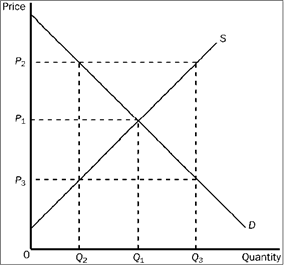 Refer to Figure 3-21. At the quantity Q 3,
Refer to Figure 3-21. At the quantity Q 3,
A) the market is in equilibrium.
B) consumer surplus is maximized.
C) the sum of consumer surplus and producer surplus is maximized.
D) the value to buyers is less than the cost to sellers.
Correct Answer

verified
Correct Answer
verified
Showing 281 - 300 of 585
Related Exams